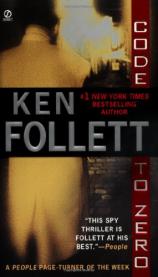Code to Zero
Review
Code to Zero
"In the [mirror] he saw a filthy hobo, dressed in rags, with matted hair, a dirty face and a crazy, pop-eyed stare. He looked at the hobo for a second, then he was hit by a terrible revelation. He started back, with a cry of shock, and the man in the mirror did the same. The hobo was himself."
What if you woke up tomorrow and had no idea who you were? What if, during the following few hours, you found you were skilled at things that no ordinary, honest person should know how to do? This is the dilemma that the protagonist, Luke, finds himself in at the beginning of the newest thriller from the masterful author of suspense Ken Follett.
With his perpetual talent for weaving historical facts with intriguing fiction, Follett takes us on another highly charged ride in CODE TO ZERO, as we watch events unfolding around the historic launch of the first US satellite, Explorer I, in 1958. As the record books show, the launch was curiously postponed without warning two days in a row, with NASA officials citing unfavorable (and unsubstantiated) weather conditions. Follett provides us with his own imaginative explanation for what might have taken place on those final days when the fate of the American space program hung in the balance.
Luke's predicament becomes even more mysterious as the narrative alternates between his search for identity and flashbacks to the year 1941, on the brink of our entry into WWII. Luke and his three closest friends are classmates at Harvard, where genius and politics often merged with interesting results. In subsequent years, these four find themselves thrown together in love and war within the murky boundaries of the CIA. Fast forward a few years and their lives have evolved in diverse directions --- Luke has followed his dream as a scientist with the NASA elite. And now, we've come full circle. Well, almost. Through instinct and cunning, Luke discovers he's been brainwashed, his memory forever locked into global amnesia. But uncovering who engineered it and why will lead him back to his classmates, friends who are harboring dark secrets, one willing to kill him to protect them.
Follett is an impeccable researcher, consistently providing an underpinning of technology and historical references to heighten the drama and bring a subtle credibility to his premise. It's not hard to find yourself wondering: Could it? Did it?, as he whisks you through the final tension-filled hours before the launch, with a chapter by chapter countdown and notations on the technology employed.
"9:30 P.M.
The instrument compartment tends to overheat prior to takeoff. The solution to this problem is typical of the crude but effective engineering of the rushed Explorer project. A container of dry ice is attached electromagnetically to the outside of the rocket. A thermostat switches on a fan whenever the compartment gets warm. Just before takeoff, the magnet is disconnected and the cooling mechanism falls to the ground."
Along with the basic factual material, there are references that are disturbing to even the most cynical of contemporary readers:
"1 A.M.
The new fuel is based on a nerve gas and is very dangerous. It is delivered to Cape Canaveral on a special train equipped with nitrogen to blanket it if any escapes. A drop on the skin will be absorbed into the bloodstream instantly and will be fatal. The technicians say: 'If you smell fish, run like hell.' "
Armed with the frightening knowledge that America's first attempt to launch a satellite resulted in an explosion upon ignition, Follett's startling premise, that saboteurs might have targeted this launch, takes on more than a veneer of reality. As he spins all the threads of deceit and betrayal into a tightly meshed, edge-of-your-seat thriller, readers are bound to question just how much of this plot was truly fabricated from Follett's fertile imagination.
Reviewed by Ann Bruns on November 1, 2001





